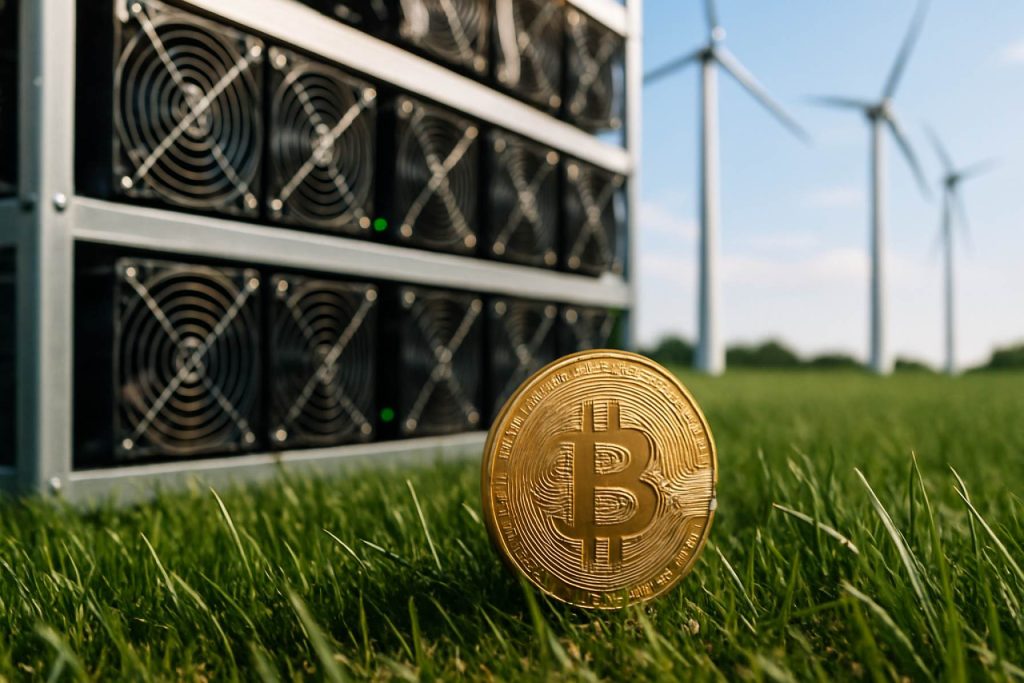
- Bitcoin mining consumes massive energy, often outpacing small countries, raising environmental concerns and impacting local resources.
- DMG Blockchain Solutions leads in sustainable blockchain innovation by adopting hydro-powered mining and partnering with AI firms to increase efficiency while reducing emissions.
- Initiatives like Terra Pool promote accountability by aggregating miners using clean energy, offering a replicable sustainability blueprint for the crypto sector.
- Other blockchain companies, such as Algorand and Morphware, are also integrating renewable energy sources and improving computational efficiency for greener operations.
- Eco-conscious mining not only lowers pollution but also appeals to investors, shapes market values, and gives consumers more control over the environmental impact of digital assets.
The remote plains of Canada quietly hum with the low, incessant churn of computer engines—unseen, yet absolutely central to the modern financial world. Amid these digital thickets, one company is emerging at the crossroads of technology and environmental responsibility: DMG Blockchain Solutions. Rather than merely mining for profit, DMG is engaged in something rarer—an environmental metamorphosis that may redefine both Bitcoin and its footprint on the planet.
Bitcoin’s Energy Dilemma
Bitcoin, often lauded for its decentralized power, has long wrestled with a darker statistic: its voracious appetite for electricity. Each coin is forged not by gold but by solving cryptographic puzzles—a computational marathon that consumes more energy annually than some small countries. These mining warehouses drain local power grids and, as studies have shown, can even nudge up household energy bills for nearby residents. The environmental calculus stretches further, placing enormous pressure on water and land resources as these high-tech mines mushroom across the landscape.
Shifting the Paradigm: Clean Power and Smart Partnerships
DMG’s team, fueled by a hybrid of vision and tech-savvy, has invested heavily in hydro-powered mining tools to combat this legacy of waste. Water rushing through Canadian turbines is now piped straight into the heart of Bitcoin’s digital machinery, reducing emissions where it counts most. In a bold step forward, DMG has entered partnerships with technology leaders in artificial intelligence, aiming to stretch productivity without stretching the earth’s resources.
These alliances extend beyond marketing jargon. Through collaborations such as Systemic Trust and Terra Pool, DMG drives operational standards that could raise the bar for the crypto sector at large. Terra Pool, for example, aggregates miners who use clean energy, creating both accountability and a blueprint for others to follow. This strategic embrace of sustainability is not without its risks—fluctuations in DMG’s stock price reveal a market eager, yet cautious, to reward bold environmental action.
Ripple Effects Across the Sector
This shift is not unique to DMG. Crypto names like Algorand and Morphware, too, are threading sustainability into their business model, whether by increasing computational efficiency or switching power sources to wind and solar. As more firms commit to cleaner practices, market dynamics shift: sustainability becomes a competitive edge, attracting both eco-conscious consumers and forward-looking investors.
Why It Matters to Everyone
For those less steeped in blockchain jargon, the story has real-world consequences. As companies like DMG change how cryptocurrency is mined, the effects ripple outward—not only lowering emissions but also influencing policy, market values, and perhaps even the cost of doing business. Everyday consumers gain a subtle but notable control, empowered to choose products and services linked to responsible energy use and lower pollution.
Supporting innovation in environmentally friendly industries has never been more essential. By watching the moves of leaders like DMG Blockchain Solutions, anyone can be a part of this silent revolution—whether through investment, advocacy, or simply by choosing businesses that commit to a greener tomorrow.
To explore more about blockchain advances shaping our world, visit Google or learn about sustainable technology initiatives through The New York Times.
Bitcoin Mining Goes Green: How DMG Blockchain and Industry Leaders Are Powering Crypto’s Eco-Revolution
Bitcoin and other cryptocurrencies have long faced scrutiny over their large carbon footprints and energy usage. However, companies like DMG Blockchain Solutions are rewriting that narrative by pioneering clean, renewable-powered mining operations. If you want to know what this could mean for the planet, your wallet, and crypto’s future, here’s what you need to know, along with actionable strategies and deeper insights.
Deeper Dive: What Sets DMG Blockchain Apart?
– Early Adoption of Renewable Energy:
DMG Blockchain uses hydroelectric power, which harnesses flowing water rather than burning fossil fuels. According to the Cambridge Centre for Alternative Finance, only about 39% of all Bitcoin mining currently relies on renewables—a metric DMG aims to drastically improve.
– Innovative Partnerships for Accountability:
Collaborations like Terra Pool—billed as the world’s first Bitcoin mining pool powered only by clean energy—promote transparency, letting participants verify the source of their mining power.
DMG Blockchain also works with Systemic Trust and other technology partners to build AI-driven efficiency into operations.
– ESG (Environmental, Social, Governance) Compliance:
DMG is among the first crypto miners to publicly report on ESG metrics, aligning with global investor demands for accountability.
Industry Trends & Market Forecasts
– Global Trends:
According to a 2023 report by BloombergNEF, the crypto-mining sector is pivoting towards renewables faster due to stricter regulations and rising investor pressure. North America is leading the charge, especially Canada where cheap, reliable hydropower is abundant.
– Investment Shifts:
BlackRock and other major investment firms are increasingly scrutinizing the carbon impact of crypto portfolios, rewarding cleaner miners with premium valuations.
– Regulatory Winds:
The European Union, and several U.S. states, are considering or have implemented rules mandating greener mining—a trend market analysts expect to accelerate in the next five years.
Key Features, Specs & Pros/Cons Overview
DMG Blockchain Features:
– Hydroelectric and carbon-neutral mining
– AI-powered optimization for energy and hash rate
– Membership in verified “clean pools” like Terra Pool
– Public reporting of environmental footprint
Pros
✔ Significantly reduces greenhouse gas emissions
✔ Attracts sustainability-focused investors
✔ May enjoy regulatory benefits as governments favor clean energy tech
Cons
✘ Relies on regional access to renewables, limiting expansion
✘ Higher upfront costs for green infrastructure
✘ Subject to greenwashing accusations if not continually audited
How DMG Mines Bitcoin with Clean Energy: A Step-by-Step How-To
1. Site Selection: DMG builds mines near hydroelectric dams to access cheap, abundant clean energy.
2. Network Integration: High-performance computers are installed to solve complex cryptographic puzzles (mining Bitcoins).
3. AI Monitoring: Algorithms optimize performance, reducing unnecessary energy use.
4. Pool Aggregation: Hash power joins Terra Pool, ensuring all BTC mined is verifiably “green.”
5. Auditing & Reporting: ESG data is shared with investors and regulators.
Frequently Asked Questions (And Expert Answers)
Q1: Is Bitcoin mining really bad for the environment?
A: Traditional mining can be—sometimes rivaling small nations (such as Finland) in energy usage. But companies like DMG are proving that mining can be powered with almost zero-emission sources.
Q2: Does clean mining actually make Bitcoin “green?”
A: Not entirely, given the network’s size and global discreteness. However, verified clean mining pools increase overall sustainability and help reduce the average carbon intensity of Bitcoin, as per studies in Nature Communications.
Q3: How does this affect crypto prices and adoption?
A: Sustainable operations may give “clean” Bitcoin a green premium, attracting institutional investors and consumers who care about ESG.
Q4: What are the risks?
A: Market volatility, regulatory changes, and local power policy shifts could impact profitability—even for green miners.
Security, Transparency & Limitations
– DMG’s clean mining pools require third-party audits to dispel greenwashing concerns.
– Blockchain transparency ensures all transactions and mining activities are publicly verifiable.
Real-World Use Cases & Compatibility
– Carbon-neutral Bitcoin is increasingly sought after for ESG-sensitive payments (think corporations looking to offset emissions).
– Compatible with most standard wallets and exchanges, but “green certified” coins may gain special listing benefits.
Comparisons: DMG vs Other Green Crypto Innovators
| Company | Energy Source | Transparency | Special Feature |
|—————–|——————-|———————-|————————|
| DMG Blockchain | Hydropower | Full ESG Reporting | Terra Pool Partnership |
| Algorand | Carbon Offsets | Partial | Proof-of-Stake Chain |
| Bitfarms | Mix of Renewables | Public Energy Data | Multi-region Sites |
Controversies & Industry Limitations
– Legacy blockchain networks still run on coal and gas in many regions.
– Some environmentalists argue that all proof-of-work mining (regardless of energy source) is inherently unsustainable compared to alternatives like proof-of-stake.
– Clean mining can lead to regional disparities—areas without abundant renewables may remain locked out.
Actionable Recommendations & Quick Tips
– If investing in cryptocurrencies, check ESG disclosures from mining firms or choose “green-certified” coins.
– Advocate for local renewable mining initiatives via petitions or community programs.
– When trading or holding crypto, consider using platforms that commit to sustainable operations.
– Stay updated with industry advances and regulatory changes through trusted news outlets such as The New York Times.
Expert Prediction
By 2030, 70%+ of global crypto mining could be powered by renewable sources if current trends—and regulatory momentum—continue (source: International Energy Agency projections).
Thanks to pioneers like DMG Blockchain and their innovative blend of technology and sustainability, the crypto industry’s future is brightening—not just metaphorically, but for the environment itself. If you’re ready to support or profit from crypto’s green revolution, the time to start is now!



